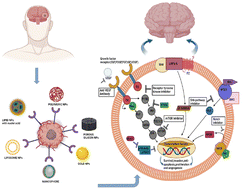Nanomedicine facilitated cell signaling blockade: difficulties and strategies to overcome glioblastoma
Abstract
Glioblastoma (GBM) is a highly aggressive and lethal type of brain tumor with complex and diverse molecular signaling pathways involved that are in its development and progression. Despite numerous attempts to develop effective treatments, the survival rate remains low. Therefore, understanding the molecular mechanisms of these pathways can aid in the development of targeted therapies for the treatment of glioblastoma. Nanomedicines have shown potential in targeting and blocking signaling pathways involved in glioblastoma. Nanomedicines can be engineered to specifically target tumor sites, bypass the blood–brain barrier (BBB), and release drugs over an extended period. However, current nanomedicine strategies also face limitations, including poor stability, toxicity, and low therapeutic efficacy. Therefore, novel and advanced nanomedicine-based strategies must be developed for enhanced drug delivery. In this review, we highlight risk factors and chemotherapeutics for the treatment of glioblastoma. Further, we discuss different nanoformulations fabricated using synthetic and natural materials for treatment and diagnosis to selectively target signaling pathways involved in GBM. Furthermore, we discuss current clinical strategies and the role of artificial intelligence in the field of nanomedicine for targeting GBM.

- This article is part of the themed collection: Journal of Materials Chemistry B Recent Review Articles


 Please wait while we load your content...
Please wait while we load your content...